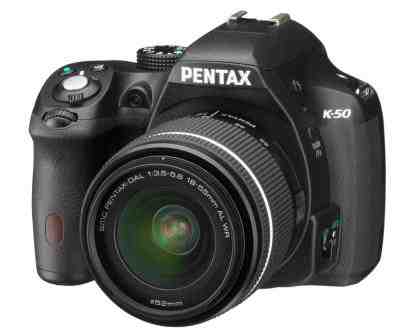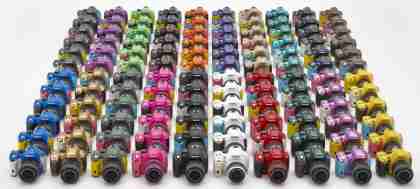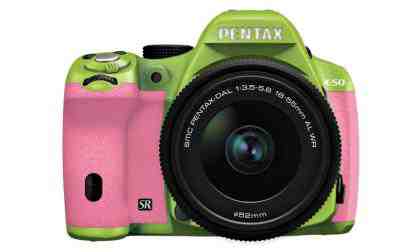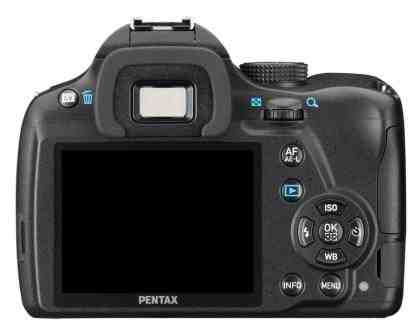The Pentax K-30 was our favourite SLR of 2012. Its large optical viewfinder, dual command dials, weather-sealed body and 6fps burst mode are features that Canon and Nikon charge considerably more than £600 for. Our only serious reservation was that its angular, sporty design wasn't easy on the eye. We don't expect a camera to be a fashion item but it's nice to be able to look at your new purchase and think happy thoughts. With the K-30, we had to remember that it's what's on the inside that counts.

VIVID COLOURS
The new Pentax K-50 is essentially the same camera as the K-30 but with a more conventional appearance. The viewfinder hump is more rounded and various other edges have been smoothed off. There's still room for some quirkiness, though, with a choice of 120 colour variations (20 options for the body, multiplied by six for the grip). These aren't clip-on extras, you pick your favourite colours (based on say a sporting team) when ordering the camera. Most of these combinations could reasonably be described as horrible – pink and green is particularly startling – but if that's what floats your boat, then we're all for it.

Many, many colours to choose from ...

... some of which should never see the light of day
A BETTER VIEW
The kit lens is new, with a plastic rather than metal mount, but it's optically identical to the K-30's kit lens and retains the same level of weather sealing. Elsewhere, very little has changed compared to the K-30. As before, the star of the show is the viewfinder, with its 0.92x magnification and 100 per cent field of view. That's significantly bigger than the viewfinders on the Canon EOS 700D (0.85x, 95%) and Nikon D5200 (0.78x, 95%), and it makes a big difference not just for adjusting manual focus but also simply for composing shots. Lots of information is visible in the viewfinder window, too, including exposure mode, manual focus, raw settings and an electronic horizon.

The controls are by far the best available at this price. The dual command dials give direct access to the shutter speed and aperture, and there are lots of smart touches that save time and let users concentrate side of on taking photos. Spinning a command dial in Program mode switches the camera to aperture- or shutter-priority mode, which we find far more useful than the usual program shift function. Options to customise the Auto ISO range are presented next to the manual ISO control, and accessed via the dedicated ISO button – so much better than rival cameras that bury these options in the menu. Self-timer, burst and exposure bracketing are sensibly grouped together, and enabling self-timer automatically disables the sensor-based stabilisation. This makes perfect sense as you'd never use the self-timer for a handheld shot. Then there's the ability to take JPEGs and retrospectively save the last shot as a RAW file – perfect for making the most of an unexpected gem.
There's no depth-of-field button but it's not something we missed. Our only slight grumble is that the navigation pad shares duties between the labelled functions and moving the autofocus point. Switching between these modes involves holding down the OK button for about a second, but we sometimes inadvertently accessed a different function when attempting to move the autofocus point. Then again, both the LCD screen and the viewfinder display make it clear which mode you're in, so with a bit of practice it shouldn't be hard to avoid this problem.
PERFORMANCE
It's a fast camera, taking between two and five photos every second, depending on the autofocus speed. Autofocus was generally very quick, with nine of the 11 autofocus points being cross-type for increased sensitivity. Autofocus was reasonably responsive in live view mode too, taking less than a second except in very low light. 2.2 seconds between shots in live view mode is almost double the speed of the Canon 700D.
Continuous shooting was just shy of the 6fps quoted speed, delivering 5.8fps in our tests. It maintained this speed for 38 frames before slowing to 2.9fps, even when chromatic aberration correction was enabled – the same feature takes a heavy toll on the Canon EOS 700D's performance. Enabling lens distortion correction slowed it right down, though, to 1.2fps after just six frames.
The best performance came in raw continuous mode. 5.8fps shooting lasted for eight frames, and then continued at a still-impressive 2.5fps – a big improvement on the Canon 700D and Nikon D7100, which set off at 5fps but quickly slowed to around 1.5fps.
VIDEO QUALITY
While the K-50 excels for ergonomics and performance, its features aren't as up-to-date as the competition's. The lack of an HDMI port seems like a strange omission in 2013. The 3in, 921,000-dot screen is sharp and bright but it's not articulated or touch-sensitive. Videos are recorded at 1080p at a choice of 24, 25 or 30fps frame rates, but clips are limited to around 17 minutes and autofocus is unavailable while recording. Video quality is fine for the odd casual clip, but details looked slightly coarse and low-light clips were noisy.
Next page for image quality examples ...
